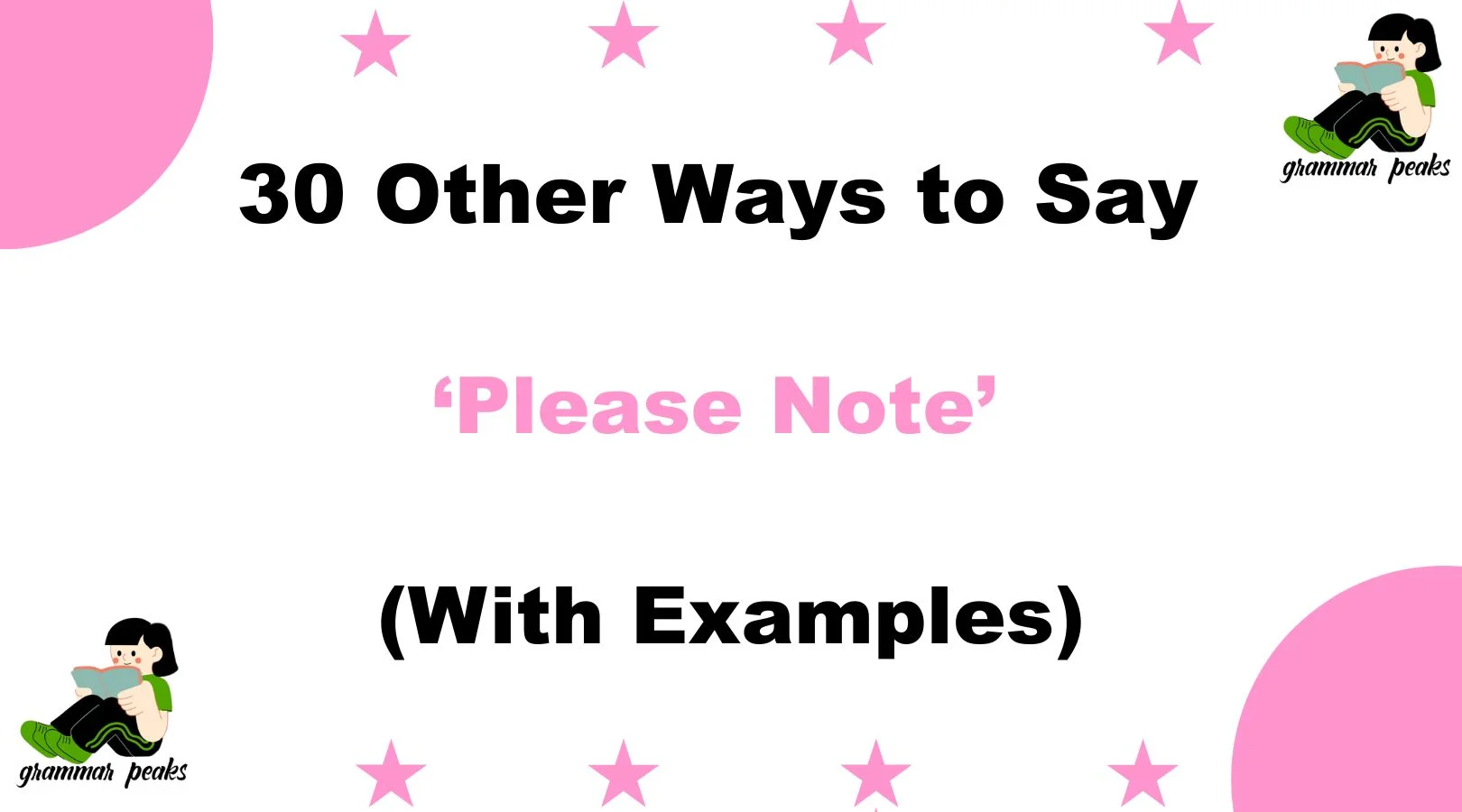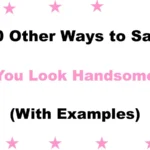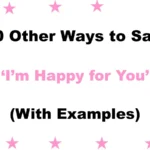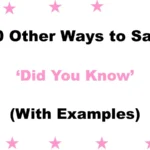In both personal and professional communication, the words we choose shape how our message is received. Saying “Please note” is functional, but it can sometimes sound cold or overly formal. Finding warmer, more thoughtful alternatives helps keep your tone empathetic, inclusive, and engaging.
Whether you’re writing to a colleague, client, or supervisor, using a more personal phrase can show care, build connection, and create clarity without sounding robotic. Here are 30 refined, professional, and kind ways to say “Please note” — complete with definitions, examples, and ideal usage guidance.
What Does “Please Note” Mean?
“Please note” is a formal phrase used to draw attention to specific information that the reader or listener should be aware of. It signals importance and is often placed before a statement that needs to be remembered, considered, or acted upon. In professional communication, it serves as a polite way to highlight instructions, warnings, or essential details without sounding too abrupt or commanding.
Although it’s clear and widely accepted in business and legal writing, it can come across as impersonal or overly rigid in more casual settings. Using alternatives with a friendlier tone can help keep communication both effective and approachable.
When to Use “Please Note”
Here are some situations where using “please note” is appropriate and effective:
- Sharing deadlines or time-sensitive updates
- Highlighting changes in policies or procedures
- Giving instructions or directions that must be followed
Is It Professional/Polite to Say “Please Note”?
Yes, “please note” is professional and polite, especially in formal or corporate communication. It conveys respect while directing attention to something important. The phrase is commonly used in business emails, reports, academic writing, and official documents where clarity and precision matter. However, while it’s polite, it may sometimes sound a bit cold or detached, especially in more personal or customer-facing messages.
In those cases, choosing a warmer or more conversational alternative can help maintain a friendly tone while still conveying the same level of importance.
Pros or Cons of Saying “Please Note”
Pros:
• Clear and concise
• Common and easily understood
• Appropriate in formal documents
Cons:
• Can sound cold or robotic
• Lacks personality
• Not suitable for emotional or human-centered writing
Synonyms for “Please Note”
- Just a quick reminder
- Kindly be aware
- I’d like to highlight
- Please be advised
- Let me point out
- Take a moment to review
- For your attention
- I wanted to bring to your attention
- As a heads-up
- Worth mentioning
- For awareness
- Keep in mind
- Just so you’re aware
- Please take into consideration
- You might want to know
- I’d like to flag
- A quick note
- Take note of
- Let’s not overlook
- You may want to keep in mind
- Don’t forget
- Mark your calendar
- Just bringing this to your attention
- Remember that
- Kindly take note
- I want to make you aware
- Something to consider
- It’s important to note
- Worth keeping in mind
- A small but important detail
1. Just a quick reminder
Definition: A friendly phrase used to nudge someone toward remembering a specific detail.
Detailed Explanation: It’s casual yet professional, often used in team settings or when following up on earlier communication.
Scenario Example: Just a quick reminder—the team call starts at 3 PM sharp.
Best Use: Gentle follow-ups, internal messages, calendar notifications.
Worst Use: Legal or formal instructions where clarity and formality are required.
Tone: Warm, informal, helpful.
2. Kindly be aware
Definition: A polite way to notify someone of important details.
Detailed Explanation: It blends formality with politeness, often seen in written communication where professionalism is important.
Scenario Example: Kindly be aware that parking will be limited due to construction.
Best Use: Client communication, formal updates, respectful notices.
Worst Use: Text messages or quick chats—it might feel too formal.
Tone: Courteous, respectful.
3. I’d like to highlight
Definition: A phrase used to draw attention to a specific point without sounding demanding.
Detailed Explanation: It shows intentionality and adds a sense of thoughtful emphasis rather than command.
Scenario Example: I’d like to highlight that all expense reports are due by Friday.
Best Use: Manager updates, presentations, project reviews.
Worst Use: Urgent warnings—it may sound too soft.
Tone: Professional, considerate.
4. Please be advised
Definition: A formal way to warn or notify someone about a specific issue.
Detailed Explanation: Common in compliance, finance, or legal writing, this phrase adds a layer of seriousness and authority.
Scenario Example: Please be advised that your account access will expire in 48 hours.
Best Use: Policy changes, compliance reminders.
Worst Use: Friendly or emotional messages.
Tone: Official, serious.
5. Let me point out
Definition: A conversational way to call attention to something specific.
Detailed Explanation: It feels less robotic than “please note,” offering a more human approach to highlighting important information.
Scenario Example: Let me point out that the figures on page 4 differ from page 6.
Best Use: Team updates, collaborative discussions, peer feedback.
Worst Use: High-stakes legal warnings—it may lack authority.
Tone: Casual, collaborative.
6. Take a moment to review
Definition: A polite way to ask someone to look over specific information.
Detailed Explanation: Encourages the reader to pause and examine something carefully, suggesting importance without sounding forceful.
Scenario Example: Take a moment to review the updated security procedures attached.
Best Use: Document sharing, process updates, internal training.
Worst Use: High-urgency or emergency alerts.
Tone: Calm, instructive.
7. For your attention
Definition: Used to flag content as important for the reader to look at.
Detailed Explanation: Slightly more formal, it signals that the information is not just informative but potentially impactful.
Scenario Example: For your attention, the new policy comes into effect next Monday.
Best Use: Memos, formal emails, board or stakeholder communication.
Worst Use: Conversational team chats—it can sound stiff.
Tone: Formal, alerting.
8. I wanted to bring to your attention
Definition: A thoughtful, considerate way to highlight something important.
Detailed Explanation: This phrase frames your message as caring and intentional rather than directive.
Scenario Example: I wanted to bring to your attention that the budget is nearing its limit.
Best Use: Feedback emails, thoughtful reminders, management communication.
Worst Use: Very short or time-sensitive notifications.
Tone: Empathetic, respectful.
9. As a heads-up
Definition: A casual way to give someone an early warning or flag something preemptively.
Detailed Explanation: This phrase has a friendly tone, perfect for informal or semi-formal contexts.
Scenario Example: As a heads-up, the system will be down for updates tomorrow night.
Best Use: Team alerts, slack messages, internal updates.
Worst Use: Formal emails or client documents.
Tone: Friendly, informal.
10. Worth mentioning
Definition: Suggests that the information may be useful or relevant without being overly direct.
Detailed Explanation: Good for soft communication when you’re unsure how important the info will be to the reader.
Scenario Example: Worth mentioning—this version of the app works better on iOS.
Best Use: Brainstorming, internal memos, casual status updates.
Worst Use: Legal notices or strict policies.
Tone: Low-pressure, conversational.
11. For awareness
Definition: Signals that the message isn’t an action item but something to be aware of.
Detailed Explanation: Often used in formal team environments to communicate non-urgent but relevant information.
Scenario Example: For awareness, the vendor is experiencing slight delivery delays.
Best Use: Cross-team updates, shared project communication.
Worst Use: Messages requiring immediate response.
Tone: Neutral, informative.
12. Keep in mind
Definition: A soft, friendly way to remind someone of a detail or consideration.
Detailed Explanation: Encourages mindfulness without sounding commanding.
Scenario Example: Keep in mind that edits must be finalized before Friday.
Best Use: Planning meetings, project reminders.
Worst Use: Legal or disciplinary communication.
Tone: Gentle, supportive.
13. Just so you’re aware
Definition: Used to let someone know about something without implying urgency.
Detailed Explanation: It’s perfect when the message is meant to inform rather than direct.
Scenario Example: Just so you’re aware, the client has rescheduled the call.
Best Use: Internal updates, casual emails, quick check-ins.
Worst Use: Policies, formal communication.
Tone: Relaxed, considerate.
14. Please take into consideration
Definition: A thoughtful way to ask someone to factor in specific information.
Detailed Explanation: Great for situations requiring decision-making or collaboration.
Scenario Example: Please take into consideration the time zone differences when scheduling.
Best Use: Project coordination, international communication.
Worst Use: Simple alerts or factual updates.
Tone: Thoughtful, collaborative.
15. You might want to know
Definition: A soft introduction to helpful or relevant information.
Detailed Explanation: Implies a sense of usefulness without demanding attention.
Scenario Example: You might want to know the printer is down on the third floor.
Best Use: Casual updates, peer-to-peer messaging.
Worst Use: High-stakes or compliance-related messaging.
Tone: Friendly, non-intrusive.
16. I’d like to flag
Definition: Often used in workplace settings to call attention to a specific detail.
Detailed Explanation: It’s direct but polite, signaling helpful input or concerns.
Scenario Example: I’d like to flag a mismatch in the data on slide 5.
Best Use: Emails, project reviews, progress reports.
Worst Use: Friendly or casual conversations—it sounds formal.
Tone: Helpful, professional.
17. A quick note
Definition: A casual intro that adds a conversational touch to the message.
Detailed Explanation: Sets a light tone while still pointing out something important.
Scenario Example: A quick note—the link in yesterday’s email was broken.
Best Use: Internal memos, team reminders.
Worst Use: Compliance or legal updates.
Tone: Light, approachable.
18. Take note of
Definition: A direct way to ask someone to acknowledge something important.
Detailed Explanation: It strikes a balance between friendly and formal.
Scenario Example: Take note of the revised start time for tomorrow’s meeting.
Best Use: Meeting agendas, performance reviews.
Worst Use: Casual or humorous messages.
Tone: Alerting, respectful.
19. Let’s not overlook
Definition: Suggests the information is easy to miss but still important.
Detailed Explanation: Encourages collective responsibility while highlighting key details.
Scenario Example: Let’s not overlook the cost implications of this change.
Best Use: Group communication, strategic planning.
Worst Use: Simple notices.
Tone: Inclusive, cautious.
20. You may want to keep in mind
Definition: A subtle nudge to consider specific information in future decisions.
Detailed Explanation: Adds a soft layer of thoughtfulness.
Scenario Example: You may want to keep in mind that John is on leave next week.
Best Use: Collaborative work, friendly updates.
Worst Use: Formal instructions or compliance alerts.
Tone: Light, considerate.
21. Don’t forget
Definition: A common reminder phrase with a more casual tone.
Detailed Explanation: Easy to use, but not suited to serious updates.
Scenario Example: Don’t forget to submit your timesheet by Friday.
Best Use: Routine reminders.
Worst Use: Formal emails or legal notices.
Tone: Friendly, casual.
22. Mark your calendar
Definition: A fun way to draw attention to a date or deadline.
Detailed Explanation: Works well for events or time-sensitive information.
Scenario Example: Mark your calendar—our quarterly meeting is on the 15th.
Best Use: Events, celebrations, team activities.
Worst Use: Warnings or critical compliance information.
Tone: Upbeat, engaging.
23. Just bringing this to your attention
Definition: A polite way to raise awareness.
Detailed Explanation: Balances formality and kindness—especially useful for sensitive matters.
Scenario Example: Just bringing this to your attention—there’s been a delay with the shipment.
Best Use: Addressing concerns, giving heads-ups.
Worst Use: Emergency messages.
Tone: Courteous, soft.
24. Remember that
Definition: Direct but still friendly—used to reinforce important facts.
Detailed Explanation: Acts as a casual cue to retain or recall details.
Scenario Example: Remember that we need board approval before proceeding.
Best Use: Strategy, leadership updates.
Worst Use: Emotional or sensitive messages.
Tone: Firm, practical.
25. Kindly take note
Definition: A polite but formal variant of “please note.”
Detailed Explanation: Keeps your tone respectful while maintaining authority.
Scenario Example: Kindly take note that the submission form has changed.
Best Use: Customer communication, professional notices.
Worst Use: Informal updates.
Tone: Courteous, structured.
26. I want to make you aware
Definition: A personal, direct way of ensuring someone is informed.
Detailed Explanation: It adds a thoughtful, proactive layer to the message.
Scenario Example: I want to make you aware of a scheduling conflict on Friday.
Best Use: 1-on-1 conversations, team management.
Worst Use: Very short or factual notifications.
Tone: Personal, sincere.
27. Something to consider
Definition: A thoughtful phrase that encourages reflection.
Detailed Explanation: Often used when offering suggestions, feedback, or analysis.
Scenario Example: Something to consider—this design may be more mobile-friendly.
Best Use: Strategic planning, brainstorming.
Worst Use: High-priority alerts.
Tone: Thoughtful, advisory.
28. It’s important to note
Definition: A more formal version that still maintains a human tone.
Detailed Explanation: Adds gravity without sounding robotic.
Scenario Example: It’s important to note that travel expenses must be pre-approved.
Best Use: Project docs, cross-functional updates.
Worst Use: Text messages or very casual exchanges.
Tone: Respectful, firm.
29. Worth keeping in mind
Definition: A gentle suggestion that encourages awareness.
Detailed Explanation: Softens the emphasis while still making a point.
Scenario Example: Worth keeping in mind—our contract renews automatically in 30 days.
Best Use: Ongoing projects, contracts.
Worst Use: Urgent reminders.
Tone: Mild, reflective.
30. A small but important detail
Definition: Helps highlight something subtle yet impactful.
Detailed Explanation: It creates curiosity and importance simultaneously.
Scenario Example: A small but important detail—logins will reset after midnight.
Best Use: System updates, feedback, workflow guidance.
Worst Use: Emergency or security alerts.
Tone: Insightful, calm.
Conclusion
Choosing the right words to express clarity and care matters more than ever—especially in today’s digital world. Replacing “please note” with warmer, clearer, or more nuanced phrases can elevate your tone, build trust, and create stronger relationships in every message. Whether you’re addressing a team, a client, or a colleague, these alternatives allow you to tailor your communication with intention and empathy—without ever sacrificing professionalism.
FAQs
1. Can I use “please note” in a casual email?
Yes, but it may feel a bit stiff. For casual emails, use friendlier options like “Just so you’re aware” or “Keep in mind.”
2. Is “please note” outdated or rude?
It’s not rude or outdated, but it can sound cold. It works for formal writing but may not suit personal or emotional messages.
3. Which alternative is best for formal documents?
“Please be advised,” “Kindly take note,” and “It’s important to note” are excellent for documents needing a formal tone.
4. How do I sound professional but approachable?
Use alternatives like “I’d like to highlight” or “Just bringing this to your attention” to balance clarity with warmth.
5. Are these phrases okay for international communication?
Absolutely. Most are globally understood and easily adaptable—just adjust formality based on the relationship and culture.

Mariah Cannon is a dedicated Senior Content Specialist at GrammarPeaks, known for her clear, engaging writing and deep knowledge of English grammar and usage. With a background in linguistics and years of experience in content development, Mariah crafts informative and accessible articles that empower readers to master the nuances of the English language. Her work reflects a commitment to clarity, education, and helping others express themselves with confidence.





